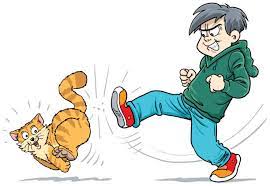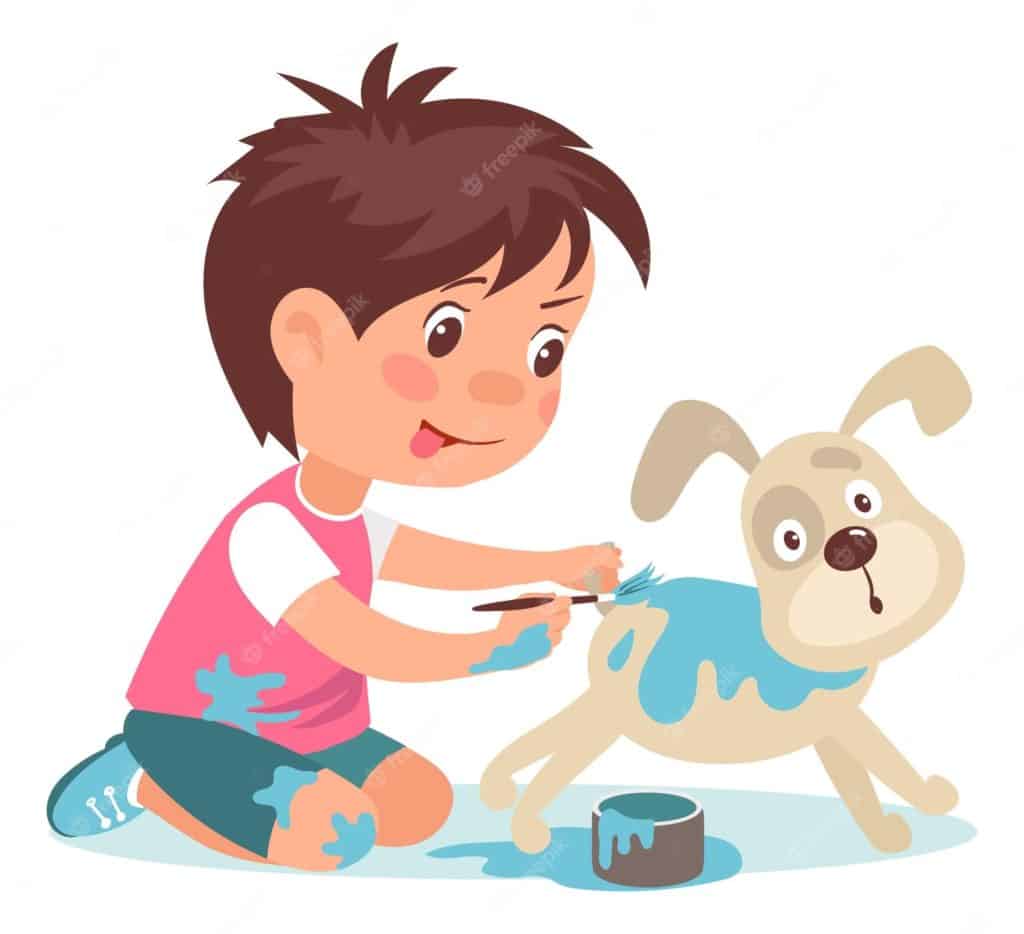When I was twenty-two years old, I wanted two things: 1. To be understood. 2. For people to think I was good at my job....Read more
Cruelty to animals through kids is a distressing problem that needs instant interest and knowledge. This behavior raises concerns not only for the well-being of innocent animals but also for the emotional improvement and destiny conduct of the child concerned.
In this short guide, we explore the stairs to address this sensitivity, emphasizing the significance of intervention, verbal exchange, and training to foster empathy and compassion in younger minds. Together, we will create safer, more compassionate surroundings for kids and animals.
Also Read: Why are kids so cruel

By developing an open and non-judgmental area for dialogue and reflection, we can find the motives behind their movements and work together to guide them toward more high-quality and compassionate behaviors. In this function, as educators, we have a unique opportunity to influence and shape the future generations of our society.
By knowing why a toddler can be cruel to animals, we can implement preventive measures, provide appropriate assistance, and ultimately foster a community of compassionate and caring folks who will increase kindness to animals and all dwelling beings around them.
What does it mean if a child hurts animals?
If an infant hurts animals, it is honestly a motive for the subject and wishes to be taken severely. It might be a sign of underlying issues the child suffers from. Sometimes, it can be a way for the child to express their emotions or cope with something they do not fully comprehend.
It’s essential to deal with this behavior early on, as it can indicate a loss of empathy or know-how of the outcomes of their moves. If you understand the kid, attempt to speak to them in a concerned and non-confrontational way. Ask them why they did what they did and try to recognize their angle.
It might be helpful to encourage them to specify their feelings and feelings thru more advantageous outlets like drawing, writing, or speaking to a person they consider. At the same time, involving the mother and father, guardians, or instructors is essential to ensure the kid receives the aid and steering they need.
They may gain professional help, like counseling or therapy, to address any emotional or behavioral issues they are dealing with. Kids’ behavior can be exchanged and enhanced with proper steerage and support.
It’s critical to intrude early and show them how to deal with animals and others with kindness and appreciation. And always prioritize the safety and proper-being of the animals worried.
Are kids hurting animals normally?
Hurting animals isn’t always considered regular or perfect behavior for kids. Teaching kids empathy, kindness, and admiration for all dwelling beings, including animals, is critical. If an infant is hurting animals, it may be a sign of underlying troubles that must be addressed.
As buddies, we can inspire open conversations about emotions and emotions. If you notice a baby behaving this way, speaking to them, recognizing what is happening, and providing guidance and help is crucial. Sometimes, kids may not completely grasp the effects of their movements, and we must assist them in analyzing and growing in a high-quality direction.
If the conduct maintains or appears excessive, it’s crucial to correctly contain the mother and father, guardians, or teachers to cope with the state of affairs. Let’s all work collectively to create compassionate and understanding surroundings where children discover ways to deal with animals and others with kindness and care.
What causes a child to be cruel to an animal
One cause can be that the kid still needs to grasp the idea of empathy. Understanding the feelings and feelings of animals may not become evident to a few kids, and they may no longer realize the effect of their movements on these harmless creatures.
Another aspect may be their surroundings and the influences around them. If a toddler witnesses aggression or cruelty toward animals of their family or community, they could unknowingly pick out on the one’s behavior and assume it is ideal. Sometimes, it can be a way for the kid to release their frustrations or feelings of powerlessness. They may not recognize how to deal with their emotions healthfully and emerge as taking it out on animals.
Lack of right training about animals and their desires may play a role. Infants who do not understand the significance of treating animals with kindness and admiration may unknowingly damage them while looking to interact or play. In some instances, beyond traumatic studies might be a thing. If the kid has been exposed to abuse or violence, they may show competitive conduct closer to animals to manage or exert control.
As pals, we must intrude and deal with this behavior. We can lightly talk to the kid and try to understand what is happening in their lifestyles that probably contributes to this cruelty. Patiently explaining the importance of kindness toward animals and the impact of their moves can go a long way in supporting them in alternating their behavior. We can also endorse seeking steerage from an expert, like a baby psychologist or counselor,
who can paint with the child to address any underlying emotional troubles. The key is to be a supportive, worrying, and affected person while supporting the child’s research, empathy, and compassion towards animals. We can make a fantastic difference in their behavior and mindset with the right approach and information.
What does it mean when a child hurts an animal?
When a child hurts an animal, it can be a regarding behavior that could suggest underlying issues or emotional challenges. This conduct should not be left out now, as it could have serious implications for both the child and the animals concerned.
There are several viable reasons why an infant might engage in such conduct:
1. Lack of Empathy. Children who harm animals can also have difficulty finding information or relating to the emotions of others, including animals. They won’t fully grasp the ache or struggle they may be causing to the animal.
2. Emotional Troubles. Children who’ve experienced trauma, abuse, or neglect may act out using hurting animals to express their own aches or emotions of powerlessness.
3. Curiosity and Lack of Awareness. Young kids may not apprehend that their movements can motivate harm to animals. They may be curious about the animal’s reactions and do not recognize the consequences of their moves.
4. Modeling Behavior. Sometimes, kids mimic competitive or dangerous behavior they have witnessed in others, whether in real life or through media.
5. Control Issues. Some youngsters may also hurt animals to exert control and strength over dwelling creatures they perceive as weaker or defenseless.
6. Conduct Disorder. In a few instances, such behavior may be a sign of behavior disease, a mental health situation characterized by persistent aggressive and antisocial behavior patterns. It is important to deal with this conduct directly and as it should be.
Early intervention can assist save you in the improvement of greater critical behavioral troubles within the destiny. Steps that can be taken encompass:
7. Educate and Develop Empathy. Help the child recognize the feelings of animals and train them to treat animals with kindness and respect.
Supervision and Boundaries. Ensure the kid is supervised around animals when the behavior improves.
8.Seek Professional Help. If the kid’s behavior persists or worsens despite efforts to deal with it, seeking the help of a baby psychologist or counselor may be helpful.
9. Provide Positive Role Models. Expose the kid to wonderful position fashions that display empathy and compassion in the direction of animals and others. Five. Encourage Positive Interactions.
Encourage the kid to interact in wonderful interactions with animals, be concerned for pets responsibly, and take part in animal-related activities that promote empathy and expertise.Remember, addressing this behavior with patience and know-how is crucial, as it can assist the child in increasing healthy emotional and social abilities and prevent harm to animals and themselves in the future.
Why am I cruel to the animal?
I need to address this situation with care and expertise. It’s not unusual for individuals to feel pressured or worried about their conduct in the direction of animals, and I appreciate your openness in discussing this. Understanding the motives behind cruelty to animals may be complex and might contain a combination of things. Some viable explanations may include the following:
- Lack of consciousness.
Sometimes, people might need to fully recognize their actions’ effect on animals fully. Developing empathy and expertise in the feelings of different living beings can take time and awareness.
- Emotional law. Difficult feelings like anger, frustration, or stress can, from time to time, cause unkind moves closer to animals. Learning healthy methods to deal with emotions can help treat animals with kindness.
- Environmental influences. The humans we have interaction with and the surroundings we are in can affect our behavior. If you’ve been around others who do not deal with animals with respect, it can affect your conduct.
- Past reviews. Childhood stories or traumas can shape our behavior as adults. Having witnessed or experienced violence towards animals will affect how you deal with them now.
- Need for management. Some people may also sense a need to exert control over animals, which could result in cruelty. As your instructor, I must emphasize that making tremendous adjustments is never too late.
Recognizing and acknowledging these emotions is a vital first step. If you find yourself being cruel to animals and need to alternate, I inspire you to seek support and talk to someone you consider, such as a family member, a pal, or a counselor. They can provide steerage and assist you in figuring out these emotions.
So, educating yourself about animal welfare and the significance of treating animals with kindness and admiration can also be helpful. Participating in activities that sell compassion towards animals, including volunteering at an animal safe haven, can help develop empathy.
Remember, our movements towards animals mirror our person, and showing kindness and empathy in the direction of them now not only benefits them but also contributes to creating a more compassionate and caring global environment for all residing beings.
How does captivity affect animals’ behavior?
Captivity may have vast effects on an animal’s conduct. The result of captivity varies depending on the species, the character animal, the satisfaction of the captive surroundings, and the duration of captivity. Here are some not-unusual ways in which captivity affects animals’ behavior.
Stress and Anxiety. Captivity can lead to continual stress and anxiety in animals. Being restricted to a constrained space, away from their natural habitat and social systems, may be distressing for many species.
Repetitive Behaviors. Some animals in captivity may increase stereotypic or repetitive behaviors, including pacing, rocking, or self-mutilation.
These behaviors are believed to be coping mechanisms for handling pressure and lethargy.
They are reduced to Exploration and Foraging. Animals in captivity regularly have restricted opportunities to explore and forage, which might be vital herbal behaviors. As a result, they will become less curious and lose their foraging talents.
Social Interactions. Social animals, mainly, go through while remote from their conspecifics. Lack of social interactions can lead to loneliness, melancholy, and declining social abilities.
Cognitive Decline. The lack of intellectual stimulation and challenges in captivity can cause cognitive decline in some animals. Their problem-fixing skills and reminiscence may also become worse over the years.
She altered Reproductive Behavior. Captivity can intervene with the reproductive behavior of positive species, mainly to reduce breeding success or a lack of reproductive abilities.
Aggression and Abnormal Behaviors. Animals in captivity might also show multiplied aggression toward each other or their caregivers. So, they will show extraordinary behaviors not seen in their wild opposite numbers.
They learned Helplessness. Some animals in captivity may also develop learned Helplessness, in which they become apathetic and stop looking to manipulate their environment, even when possible.
Fear of Humans. Constant exposure to humans, mainly in situations related to mistreatment or harassment, can result in fear and mistrust of human beings, making it challenging for the animals to be reintroduced to the wild.
It is important to be aware that not all captive environments are the same, and there are instances in which animals are saved in nicely-designed facilities with enriching environments that prioritize their physical and mental well-being. Such environments can mitigate a number of the bad results of captivity.
Nevertheless, the impact of captivity on animal behavior highlights the importance of responsible and ethical practices in maintaining animals in captivity, particularly for conservation, studies, and enjoyment functions. Providing suitable habitats, mental stimulation, and social opportunities can drastically improve the welfare of captive animals.
In some instances, efforts are made to reintroduce animals to the wild or provide sanctuary environments where they could live in a more natural and enriching place.

Related Articles:
- Can Kids Eat The Adult Happy Meal
- Are Kids Allowed In Dave & Buster
- How To Attract Kids Towards You
- Can Short Parents Have Tall Kids
- Do 7 Year Old Kids Still Play With Toys
- Why Do kids Wear Hoodies In The Summer

When I was twenty-two years old, I wanted two things: 1. To be understood. 2. For people to think I was good at my job. As a first time founder, I remember feeling under-qualified. I felt like an impostor—and it showed. I struggled to communicate my value in a way that my colleagues and potential investors could understand. I realized I needed to clarify my message and use social media as a tool to help me build my personal brand. This would help me look more credible, I thought. So I got to work. I updated my social media profiles, built a personal website, and began sharing my story online. The more content I shared, the more confident I became. And the more confident I became, the more credible I appeared. Now i am writing blogs for madeforkids.co.uk on different topics on kids.
- Latest Posts by Anna Vatuone
-
What Are The Uses Of A Drone
- -
What Are The Uses Of Playhouse
- -
How To Get A Child To Warm Up To You
- All Posts
